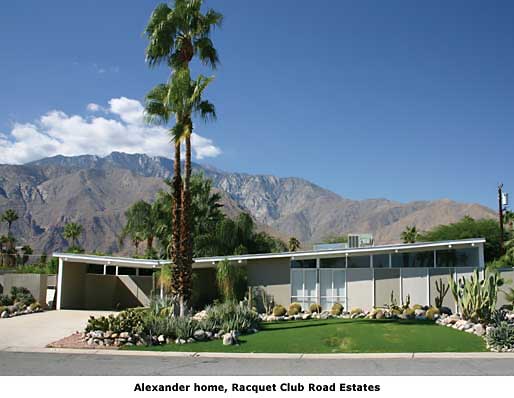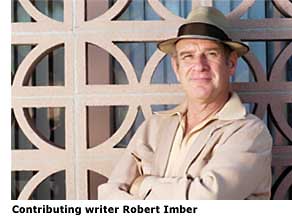The Alexander Homes - Page 3
These later houses incorporated the fundamentals from previous Alexanders but in an enlarged version. More models were added, including a center atrium plan, coincidentally in parallel to homes Joe Eichler was introducing in Northern California. While there are countless similarities in the groundbreaking housing concepts advanced by both Eichler and the Alexanders, historic records don't mention that they were familiar with each other's work. But each in their own right widely influenced housing throughout the United States in ways unlike anyone else.
Deluxe amenities included elaborate fireplaces, deep roof overhangs, built-in kitchen appliances, Shoji screen room dividers, terrazzo-like vinyl flooring inlaid with bronze trim, acoustic ceiling panels, sunken tubs and showers, and mirrored walls. And these Alexanders were insulated! Woven redwood fencing neatly defined property lines, and two trees (though not always palm trees) remained the mainstay of front landscaping.

Citywide the collection of Alexanders ranges from 1,225 square feet in Racquet Club Road Estates at the far north end of town to over 2,500 square feet, and were originally priced from $16,950 to the low $50,000s. But in the 1970s Palm Springs entered a tremendous economic decline and exodus of population, so much of the architecture remained untouched for decades. More recently, an influx of newcomers and the increasing boomer market in search of modernist homes have been perhaps the primary forces in the growing revitalization of Palm Springs. Today, a refurbished Alexander sells from $400,000 to well over one-million dollars.
In its decade-plus of building in Palm Springs, the Alexander Company and Palmer and Krisel garnered frequent national attention, sharing innumerable awards for excellence in planning, design, and construction. Bill Krisel's lavish spec house for the Alexanders, partially intended for publicity purposes, was so treasured by Helene Alexander that she insisted they move into it themselves. Hovering over an inclined cul-de-sac site and balanced on winged walls of local stone, the 'House of Tomorrow' was featured along with Bob and Helene Alexander (and daughter Jill) in a September 1962 Look magazine article, 'The Way Out Life' that boasted "at Palm Springs, dreams of modern luxury come true."
The Alexander family philanthropy was legion as was their eminent standing in Palm Springs' social set in an era of martini-toting Ratpackers and elite snowbirds. Their house is a boomerang-shaped assemblage of circular themes and hexagonal levels that takes advantage of sloping topography to command exhilarating views. A one-of-a-kind architectural achievement built at a cost of $300,000 in a day when $100,000 was extravagant, much of the House of Tomorrow's current fame stems from it's year in service as Elvis and Priscilla Presley's honeymoon hideaway.
Sadly, the Alexanders never knew the lasting impact of their contribution to the community and to housing in America. On Sunday, November 14, 1965, at the peak of their lives and careers, George and Bob Alexander were killed, along with wives Mildred ('Jimmie') and Helene, in a foul-weather private plane crash that devastated the community and their immense circle of friends and associates.
Postwar technology, inventive new materials, the needs of a more sophisticated lifestyle, and an underlying informality of the Alexanders' houses influenced tract homes in communities well beyond Southern California. Along with Eichler's developments to the north, the Alexanders' Palm Springs houses were instrumental in shaping a new way of living and of looking at American residential mass-market design.

Endeavoring to heed those lessons and protect from the sameness brought by popular crass development, preservationists today, along with countless residents and visitors. keep a watchful eye over Palm Springs' valuable architectural repository. As striking as when they were new, Alexander neighborhoods throughout Palm Springs are once again fashionable enclaves, popular among first-time home buyers, retiring baby boomers, and architecture devotees from near and far.
Active in the preservation of mid-century modern architecture, contributing writer Robert Imber conducts regular architectural tours and lectures on Palm Springs modern architecture through his company, PS Modern Tours (760-318-6118). He is also executive producer of 'Visions of Utopia,' the first full-length feature film on Palm Springs modern, premiering February 2006 at the Palm Springs Art Museum.
Photos: Adriene Biondo and John Eng, Barry Sturgill (Imber pic)
- « first
- ‹ previous
- 1
- 2
- 3




